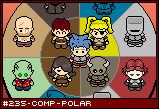| Three Hundred |
| - Index Page |
| - About... |
| - By Year |
| Collections |
| - Comp-Grid |
| - Procedural |
| - Tactics |
| - Tiny Crawl |
| - Misc |
| Previous | Mechanic #235 | Next |
The original [#017 - Composition Army] entry concerned a unit made up of individual characters, where the position of each character (both in relation to the unit and to each other) made a difference. This is basically just the same idea, but with a polar coordinate system.
![[polar1.png]](set12/img/entry235-polar1.png)
At the most basic level, it is a game of combat between circular units. These units are comprised of individual combatants, each with their own abilities and talents to contribute to the group. Positions matter, so the combatants on the outer ring will be the ones who engage in combat first, followed by the inner ring, and finally the unit commander.
![[polar2.png]](set12/img/entry235-polar2.png)
Each unit may contribute some ability to the unit or to combatants adjacent to the combatant. For instance, the commander (guy at the center) will give abilities to everybody in the unit. A cleric in the inner ring might heal the units it touches on the outer ring. A guardian will defend units adjacent to it on the same ring, and finally, berserkers may increase in strength when you have several of them in a row. In order to best make use of the ring system, rings (inner and outer) may be rotated clockwise or counterclockwise at the beginning of the move to create new defensive positions and attack strategies.
![[polar3.png]](set12/img/entry235-polar3.png)
With combat, a unit can attack another unit within a certain range, and any slot on the opponent's outer ring that falls within that range can be a target. If two adjacent slots are missing combatants (either from being empty or from losing combatants to battle), whatever inner ring slot is touching the line between empty slots may be attacked (You attack the line between empty slots). If that slot is empty on the inner ring, the commander becomes available to hit. And that's basically it. Essentially a rank and file miniatures game, but in a series of rotating rings.
![[prototype]](set12/img/entry235-prototype.png)
|
